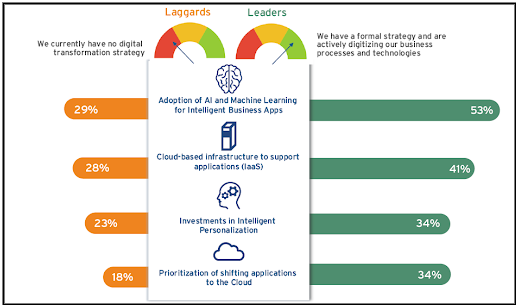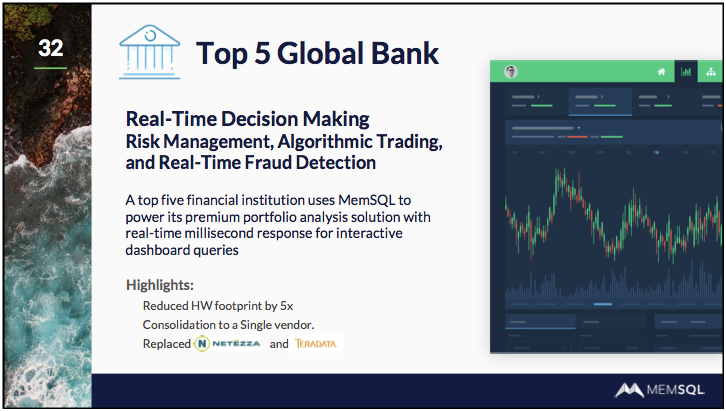
HOAP databases combine transaction processing and analytics processing in a single fast, responsive, SQL-compliant database. HOAP databases, such as SingleStore, greatly simplify your data architecture, while offering improvements in both performance and price.
SingleStore is an outstanding example of a modern HOAP database, with a rapidly growing customer base, and is already used for critical processing in high tech, media, finance, and government, among other sectors.
SingleStore is also simply a very fast relational database, maintaining the highest levels of performance, and cost-effective at enterprise scale. To learn more, view our webinar, or read on – and then view the webinar.
The Growth of HOAP for Systems of Engagement
HOAP databases are a new class of databases that promise to revolutionize how data is gathered, managed, analyzed, and used. These databases combine transaction processing and analytics processing in real time, enabling a series of workloads – including operational analytics, fraud detection, telemetry of systems or Internet of Things sensors, and real-time analytics powering dashboards – on currently updated data.
HOAP databases generally support the SQL format – which means that they’re relational databases, unlike NoSQL stores for unstructured data – and thereby support business intelligence tools and user queries that require SQL. Names for this group of databases include hybrid operational and analytics databases (HOAP), hybrid transactional and analytics databases (HTAP), and translytical databases (for “transactional plus analytical”). Most NewSQL databases fit in the HOAP, HTAP, and translytical categories as well.
In the webinar, Matt Aslett, Research VP at 451 Research, shows that digital transformation is happening now. In a 2018 survey, 40 percent of respondents are actively digitizing their business process and/or assets, within a formal strategy. 47 percent are considering or evaluating developing a strategy, and only 14% are making no effort. (Numbers do not add up to 100 percent due to rounding.)

Leaders in digital transformation show more adoption of machine learning and AI, more use of cloud resources, and greater investments in intelligent personalization of their online offerings – a key use of HOAP databases. HOAP databases deliver high performance while reducing the cost and complexity of the analytics services that drive personalization.
To do this, HOAP databases must provide simplicity, performance (combining transactions and analytics responsiveness with sub-second response time), and cost-effectiveness. Often, a HOAP database is able to deliver equal or faster performance than an analytics-focused OLAP database, on commodity hardware, and at a cost that is less expensive than a transaction-oriented OLTP database. In this way, HOAP databases provide the best of both worlds, OLTP and OLAP, but faster and cheaper than either.
Investment is shifting to new systems of engagement solutions, which drive personalization, and more responsive services that are difficult to deliver with mature system of record databases. HOAP databases are currently a small, but growing share of the overall database market, projected to grow from around 10 percent of incremental revenue today to more than 30 percent in five years.
How SingleStore Helps Drive the Growth of HOAP
Mike Boyarski, senior director of product marketing at SingleStore, describes the advantages of SingleStore, a charter member of the HOAP camp: SingleStore is extremely performant, with responsiveness in the area of 10x over legacy alternatives; simple, with an easy to use and easy to access SQL architecture; and cost-effective, delivering unmatched responsiveness for a third or less the cost of alternatives.
SingleStore achieves these benefits through a converged architecture, which combines the distributed nature of NoSQL solutions with the benefits of a relational SQL architecture. With this architecture, SingleStore can combine the high-speed ingest of a NoSQL database and the real-time analytics of an OLAP database, but against updated, not stale, structured data.
SingleStore was originally introduced as an in-memory database, but now supports in-memory processing for rowstore tables and disk-based storage for columnstore. A single SingleStore database can replace key value stores, expensive in-memory caching, a data warehouse, an operational database, and more.

Use cases for SingleStore include fraud detection in real time; ad personalization; ad and streaming media analytics; real-time analytics for dashboards; and simultaneous data ingest and analytics for the Internet of Things (IoT).
SingleStore is also a strong alternative when a traditional OLTP-ETL-OLAP processing chain is overwhelmed. Traditional architectures are seeing increasing volumes of incoming data on the online transaction processing (OLTP) side; increasing queries on the online analytics processing (OLAP) side; and an overburdened extract, transform, and load (ETL) process to move and condition data from OLTP into OLAP. In these use cases, the change in functionality and performance from making the relatively easy move to SingleStore, collapsing many cumbersome processes onto one powerful database, can be simply revolutionary.
Webinar Recording and Slides
You can easily access the webinar recording and slides to learn more about SingleStore. You can also download the research paper that complements the webinar, written by 451 Research.
Free Trial
We also offer a free trial of SingleStore for 30 days. Download the free trial today.





